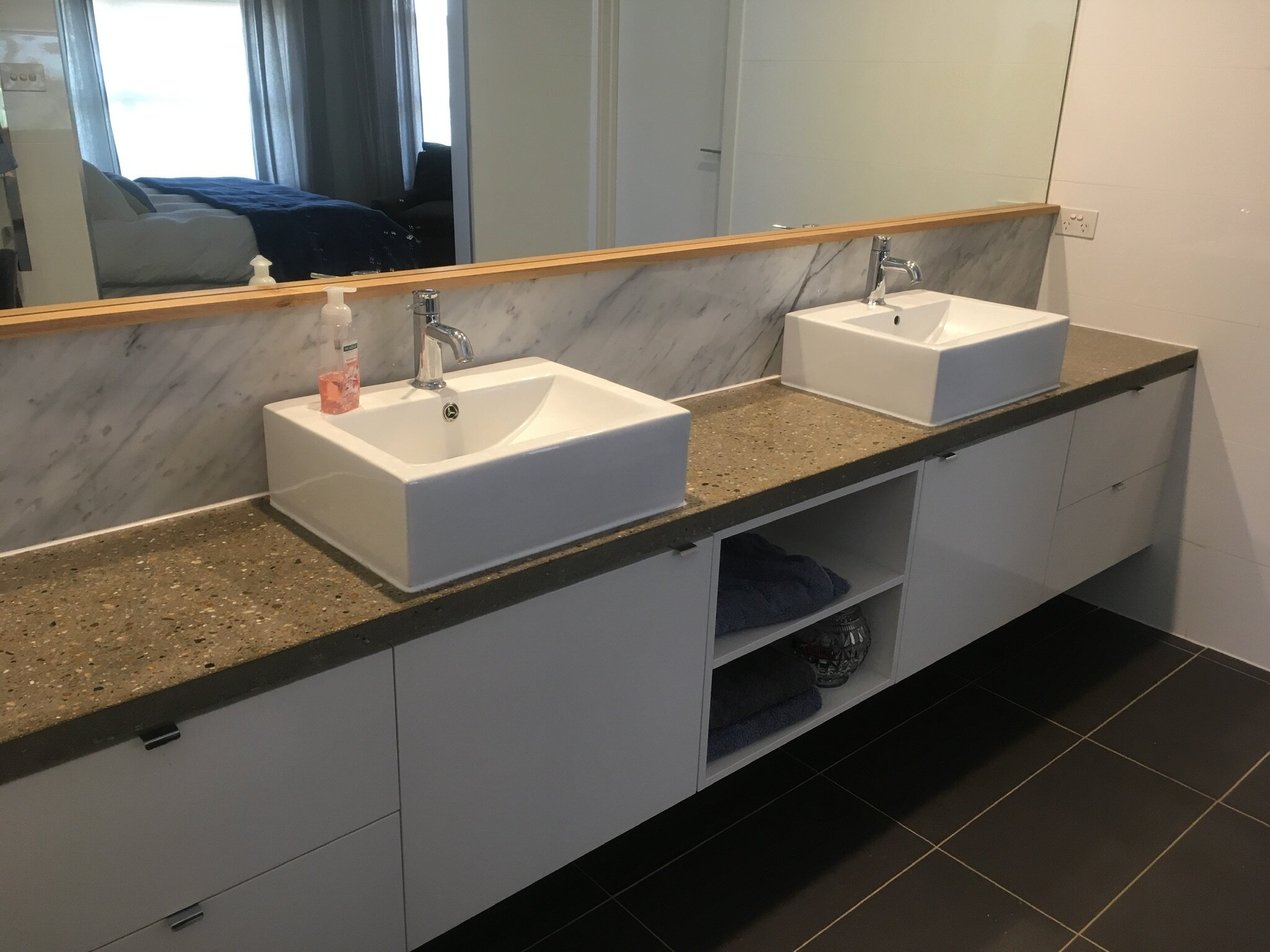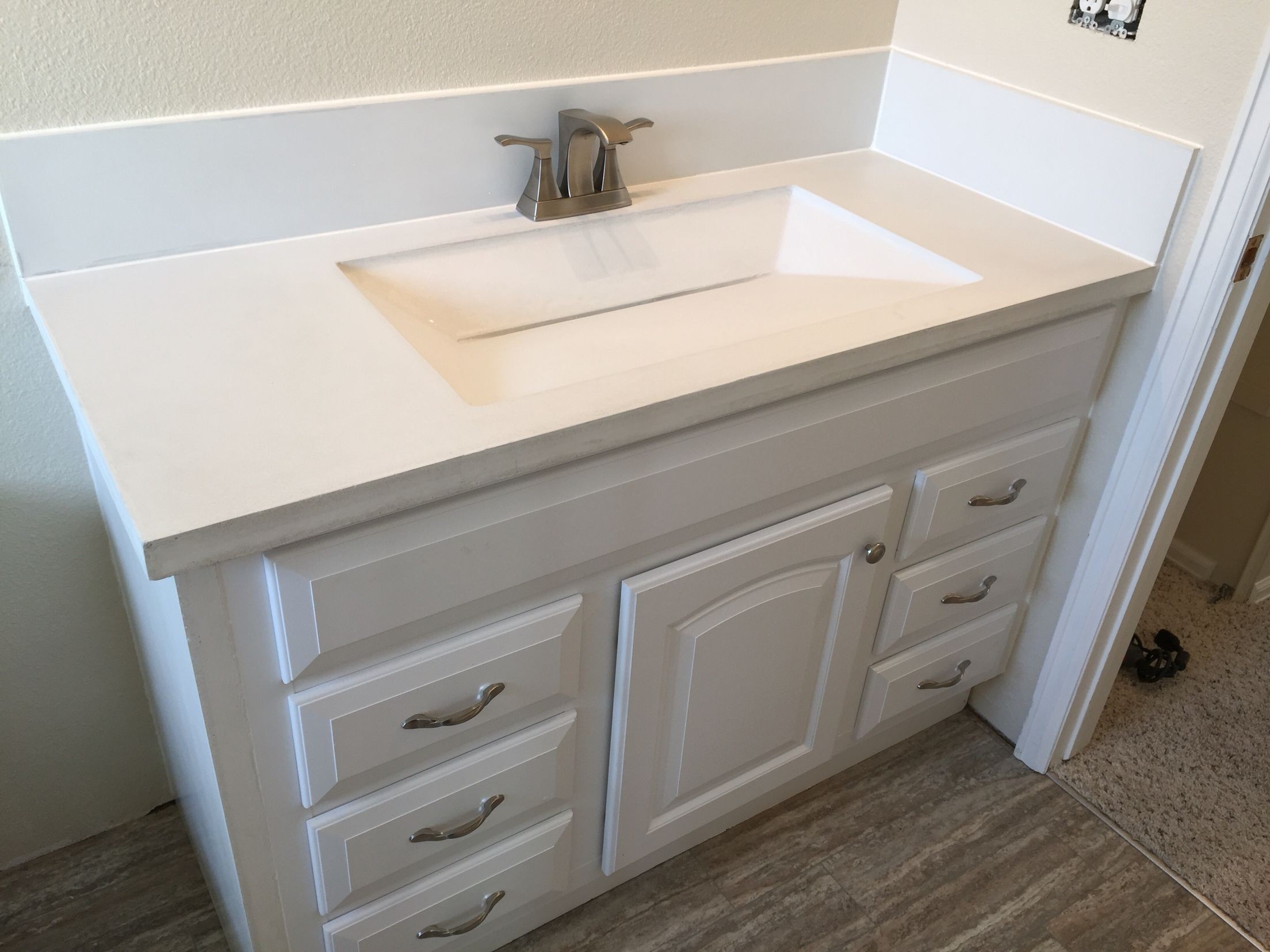The Appeal of Concrete Countertops in Bathroom Vanities

Concrete countertops are becoming increasingly popular in bathroom vanities, offering a unique blend of durability, aesthetics, and sustainability. Their robust nature and customizable design options make them a compelling choice for homeowners seeking a long-lasting and stylish bathroom upgrade.
Durability and Longevity
Concrete countertops are renowned for their exceptional durability, surpassing many other materials commonly used in bathroom vanities. Their inherent strength makes them resistant to scratches, chips, and heat, ensuring they withstand the daily wear and tear of a bathroom environment. This durability translates into longevity, as concrete countertops can last for decades with proper care, making them a valuable investment for any homeowner.
Aesthetic Appeal and Customization
Concrete’s natural beauty and versatility in design contribute to its aesthetic appeal. Its unique texture and color variations create a distinctive look, adding a touch of rustic charm or modern elegance to any bathroom. The customization options are vast, allowing homeowners to personalize their countertops with various finishes, colors, and patterns. This includes incorporating aggregate materials like glass, quartz, or recycled materials, adding a unique touch to the countertop’s design.
Environmental Benefits
Concrete countertops are an environmentally friendly choice for bathroom vanities. They are made from readily available materials, reducing the need for imported resources. Additionally, concrete is a recyclable material, contributing to sustainable construction practices. By choosing concrete countertops, homeowners can reduce their environmental impact and create a more sustainable bathroom space.
Design Considerations for Concrete Bathroom Vanities: Concrete Countertop Bathroom Vanity

Designing a bathroom vanity with a concrete countertop involves careful consideration of various design elements to achieve the desired aesthetic and functionality. This section explores key design considerations, focusing on concrete countertop finishes, vanity layout, and the importance of sealing.
Concrete Countertop Finishes
The finish applied to a concrete countertop significantly impacts its visual appeal and overall bathroom aesthetic. Here’s a table highlighting different finishes and their effects:
| Finish | Impact on Bathroom Aesthetic |
|---|---|
| Polished | Creates a sleek, modern, and reflective surface, enhancing the natural beauty of the concrete. |
| Honed | Provides a smooth, matte finish with a subtle sheen, offering a more understated and contemporary look. |
| Stained | Allows for customization with various colors and patterns, adding warmth and depth to the concrete surface. |
Bathroom Vanity Layout with Concrete Countertop, Concrete countertop bathroom vanity
A well-designed bathroom vanity layout maximizes functionality and visual appeal. Here’s an example incorporating a concrete countertop:
* Storage: The vanity can feature drawers and cabinets for storing toiletries, towels, and other bathroom essentials. Open shelves can provide additional display space for decorative items.
* Lighting: Under-cabinet lighting illuminates the countertop and sink area, enhancing visibility and creating a warm ambiance.
* Sink Placement: A vessel sink or a drop-in sink can be seamlessly integrated into the concrete countertop, adding a touch of elegance.
* Mirror: A large, framed mirror above the vanity reflects light, making the bathroom appear larger and brighter.
Sealing Concrete Countertops
Sealing a concrete countertop is crucial for protecting it from water damage and staining. Concrete is a porous material, and without proper sealing, water and spills can penetrate the surface, leading to discoloration and potential structural issues.
Sealing creates a protective barrier, preventing water and stains from penetrating the concrete and ensuring its longevity.
Regular sealing, typically every 1-2 years, is recommended to maintain the countertop’s beauty and functionality.
Concrete Countertop Bathroom Vanity Installation and Maintenance

Installing a concrete countertop in a bathroom vanity can be a rewarding DIY project, adding a unique and durable element to your bathroom. However, it requires careful planning and execution to ensure a successful installation and long-lasting beauty. This section will guide you through the installation process and provide essential maintenance tips to keep your concrete countertop in top condition.
Concrete Countertop Bathroom Vanity Installation
Installing a concrete countertop involves several steps, each requiring attention to detail.
- Prepare the Vanity Base: Ensure the vanity base is sturdy and level. If necessary, reinforce the base to support the weight of the concrete countertop.
- Create a Template: Measure the vanity opening and create a template using plywood or cardboard. This template will serve as a guide for cutting the countertop to the desired size.
- Pour the Concrete: Pour the concrete mixture into a mold or directly onto the vanity base, using the template as a guide. Use a trowel to level and smooth the surface.
- Cure the Concrete: Allow the concrete to cure for at least 24 hours, and ideally for several days, to achieve optimal strength and durability.
- Seal the Concrete: After curing, apply a sealant to protect the countertop from water damage and staining. Sealant can be applied with a brush or roller, following the manufacturer’s instructions.
- Install the Sink: Cut the sink hole in the countertop using a diamond-tipped hole saw. Carefully install the sink, ensuring a secure and watertight fit.
- Finish the Edges: Apply a decorative edge to the countertop, such as a bullnose or a straight edge, to create a finished look.
- Install the Countertop: Carefully lift the countertop onto the vanity base and secure it using appropriate fasteners.
Concrete Countertop Bathroom Vanity Maintenance
Proper maintenance is crucial to preserving the beauty and longevity of your concrete countertop.
- Regular Cleaning: Clean the countertop regularly with a mild soap and water solution. Avoid abrasive cleaners or harsh chemicals that can damage the surface.
- Prevent Staining: Wipe up spills immediately to prevent staining. For stubborn stains, use a poultice made of baking soda and water, or a commercial concrete cleaner.
- Reseal Periodically: Reapply sealant every 1-2 years, or more frequently if the countertop is exposed to heavy wear or water damage.
Challenges and Solutions for Concrete Countertop Installation
Installing concrete countertops in bathrooms can present some challenges.
- Weight: Concrete countertops are heavy, so ensure the vanity base is sturdy enough to support the weight. Consider reinforcing the base or using a lighter concrete mix.
- Water Damage: Concrete is porous and can be susceptible to water damage. Proper sealing is essential to protect the countertop from water penetration.
- Cracking: Concrete can crack if it is not properly supported or if it experiences extreme temperature fluctuations. Use a reinforced concrete mix and avoid placing hot items directly on the countertop.
